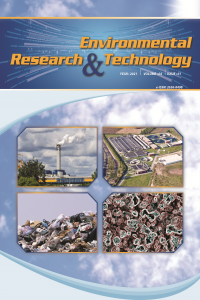Conference Paper
Year 2021,
Volume: 4 Issue: 1, 73 - 82, 31.03.2021
Abstract
Boron is widely used in various areas of modern technology. Due to the environmental problems arising during the production and use, the studies on the removal and recovery of boron from wastewater have been increased recently. Membrane distillation (MD) system is smaller in size with respect to other common distillation systems and needs lower operating temperatures. In addition, the equipment costs are reduced and the safety of the process increases since it operates at lower pressures. Moreover, the membrane distillation process can remove pollutants from water without using chemicals. In this study, boron rejection from aqueous solutions and wastewater was investigated by using direct contact membrane distillation (DCMD) system where both surfaces of a porous hydrophobic membrane were in contact with liquid streams. The effects of various parameters (pH, feed concentration, feed temperature, etc.) on boron rejection were investigated and the highest boron rejection was found to be 50 % when pH=10 at 50 °C and with feeding by a pump of 54 rpm. According to the test results of wastewater from Kırka Borax treatment plants, the mean distillate fluxes were found as 13, 16 and 14 L m-2 h-1 at the feed temperatures of 30, 40 and 50 °C, respectively. The boron removal percentages were found to be 47, 64 and 48 % at 30, 40 and 50 °C, respectively. It was observed in the XRD spectra that the crystals in wastewater mainly consist of Na2B(OH)4Cl and Mg2B2O5 structures.
Supporting Institution
Scientific Research Projects Commission of Eskişehir Osmangazi University
Project Number
201115040
References
- [1]. Official Gazette, Regulation on Water Pollution Control, , no 25687, 31 December 2004.
- [2]. V. Kochkodan, N.B. Darwish and N. Hilal, “The Chemistry of Boron In Water, Boron Separation Processes,” Elsevier 1st ed., pp. 35-62, 2015.
- [3]. M. Khayet, T. Matsuura, “Pervaporation and vacuum membrane distillation process: modeling and experiments,” AIChE Journal, Vol. 50(8), pp. 1697-1712, 2004.
- [4]. A. Alkhudhiri, N. Darwish and N. Hilal, “Membrane Distillation: A Comprehensive Review,” Desalination, Vol. 287 pp. 2-18, 2012.
- [5]. P. Onsekizoğlu, “Effects of Osmotic Distillation and Membrane Distillation Applications on Product Quality in Apple Juice Production,” Doctorate Thesis, Hacettepe University, Ankara, 2010.
- [6]. L. Li, Y. Guan, F. Cheng and Y. Liu, “Treatment of high salinity brines by direct contact membrane distillation: effect of membrane characteristics and salinity,” Chemosphere, Vol. 140, pp. 143-149, 2015.
- [7]. M. Gryta, “Water purification by membrane distillation process,” Separation Science and Technology, Vol 41, pp. 1789-1798, 2006.
- [8]. M. Qtaishat, M. Khayet and T. Matsuura, “Novel porous composite hydrophobic/hydrophilic polysulfone membranes for desalination by direct contact membrane distillation,” J. Membr. Sci., Vol. 329, pp. 1-2, 193-200, 2009.
- [9]. D. Hou, J. Wang, X. Sun, Z. Luan, C. Zhao and X. Ren, “Boron removal from aqueous solution by direct contact membrane distillation,” Journal of Hazardous Materials, Vol. 177 pp. 613-619, 2010.
- [10]. R. Bouchrit, “Direct contact membrane distillation: capability to treat hyper-saline solution,” Desalination, Vol. 376, pp. 117-129, 2015.
- [11]. C. M. Tun, J.T. Fane and M.R. Sheikholeslami, “Membrane distillation crystallization of concentrated salts-flux and crystal formation,” J.Membr.Sci., Vol. 257, pp. 144-155, 2005.
Year 2021,
Volume: 4 Issue: 1, 73 - 82, 31.03.2021
Abstract
Project Number
201115040
References
- [1]. Official Gazette, Regulation on Water Pollution Control, , no 25687, 31 December 2004.
- [2]. V. Kochkodan, N.B. Darwish and N. Hilal, “The Chemistry of Boron In Water, Boron Separation Processes,” Elsevier 1st ed., pp. 35-62, 2015.
- [3]. M. Khayet, T. Matsuura, “Pervaporation and vacuum membrane distillation process: modeling and experiments,” AIChE Journal, Vol. 50(8), pp. 1697-1712, 2004.
- [4]. A. Alkhudhiri, N. Darwish and N. Hilal, “Membrane Distillation: A Comprehensive Review,” Desalination, Vol. 287 pp. 2-18, 2012.
- [5]. P. Onsekizoğlu, “Effects of Osmotic Distillation and Membrane Distillation Applications on Product Quality in Apple Juice Production,” Doctorate Thesis, Hacettepe University, Ankara, 2010.
- [6]. L. Li, Y. Guan, F. Cheng and Y. Liu, “Treatment of high salinity brines by direct contact membrane distillation: effect of membrane characteristics and salinity,” Chemosphere, Vol. 140, pp. 143-149, 2015.
- [7]. M. Gryta, “Water purification by membrane distillation process,” Separation Science and Technology, Vol 41, pp. 1789-1798, 2006.
- [8]. M. Qtaishat, M. Khayet and T. Matsuura, “Novel porous composite hydrophobic/hydrophilic polysulfone membranes for desalination by direct contact membrane distillation,” J. Membr. Sci., Vol. 329, pp. 1-2, 193-200, 2009.
- [9]. D. Hou, J. Wang, X. Sun, Z. Luan, C. Zhao and X. Ren, “Boron removal from aqueous solution by direct contact membrane distillation,” Journal of Hazardous Materials, Vol. 177 pp. 613-619, 2010.
- [10]. R. Bouchrit, “Direct contact membrane distillation: capability to treat hyper-saline solution,” Desalination, Vol. 376, pp. 117-129, 2015.
- [11]. C. M. Tun, J.T. Fane and M.R. Sheikholeslami, “Membrane distillation crystallization of concentrated salts-flux and crystal formation,” J.Membr.Sci., Vol. 257, pp. 144-155, 2005.
There are 11 citations in total.
Details
| Primary Language | English |
|---|---|
| Subjects | Environmental Engineering, Water Resources and Water Structures |
| Journal Section | Research Articles |
| Authors | |
| Project Number | 201115040 |
| Publication Date | March 31, 2021 |
| Submission Date | December 18, 2020 |
| Acceptance Date | January 13, 2021 |
| Published in Issue | Year 2021 Volume: 4 Issue: 1 |


